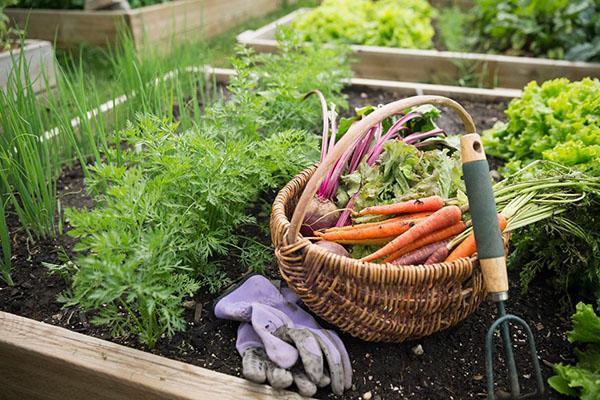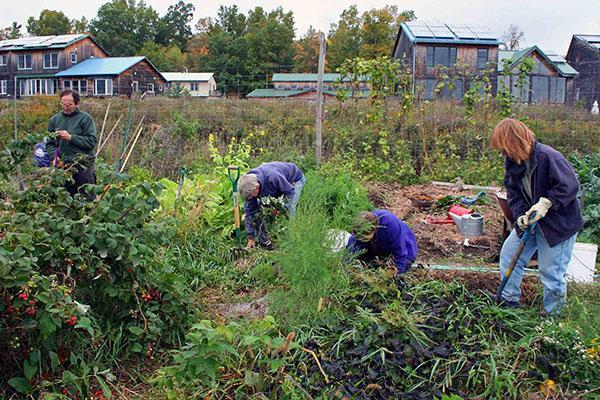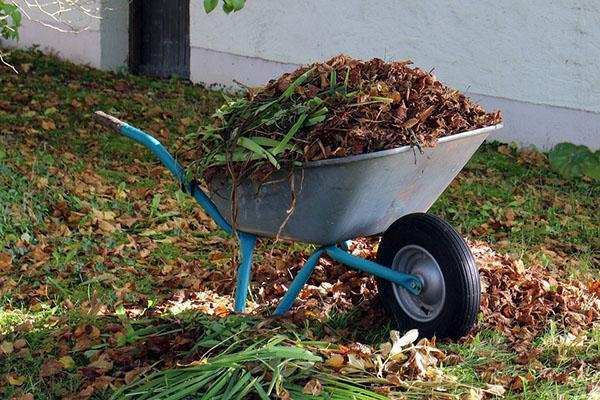The troubles of the summer resident in the garden in September
 Only a few weeks remain before the onset of cold weather, and the summer resident still has so much to do! A vegetable garden in September requires both attention and application of physical strength. Behind weeding, significantly fewer plants need watering and feeding. Now gardeners face other, no less important tasks.
Only a few weeks remain before the onset of cold weather, and the summer resident still has so much to do! A vegetable garden in September requires both attention and application of physical strength. Behind weeding, significantly fewer plants need watering and feeding. Now gardeners face other, no less important tasks.
Harvesting and storage in September

In the first month of autumn, while it is warm and dry, they collect in the garden:
- tomatoes;
- sweet and hot peppers;
- eggplant;
- cauliflower, white cabbage, Savoy cabbage and Peking cabbage of early autumn ripening;
- radishes and radishes sown in the second half of summer;
- spicy flavoring greens.
Until the years of pollinating insects have stopped, asparagus beans are actively bearing fruit, zucchini and squash are tied. Not a single month of the year compares to September for the variety and abundance of crops. On the potato ridges, where the tops have already wilted and dried up, digging potatoes, harvesting beets, carrots, it is time to collect root parsley and celery.
Although it is still very warm during the day, at night the first autumn month can surprise you with a freeze.
Even a short-term drop in temperature threatens to reduce the quality and soon spoil the fruits of all nightshade crops, zucchini and cucumbers. Pumpkins and the tops of root crops that rise above the soil level suffer from frost. This should be taken into account when leaving the work schedule in the garden in September.
 If cold rainy days are approaching, it is useful to cover the beds that have not yet been freed from plants with non-woven material or film. Tomatoes, peppers, pumpkins can be removed even unripe. At home, in dry conditions, they gradually ripen.
If cold rainy days are approaching, it is useful to cover the beds that have not yet been freed from plants with non-woven material or film. Tomatoes, peppers, pumpkins can be removed even unripe. At home, in dry conditions, they gradually ripen.
Before the garden is completely bare, the storage is prepared in advance. Basements and cellars by September should be dried and cleaned, treated from fungus and rot, and the racks and containers should be washed. In order for root crops, potatoes, cabbage and pumpkins to be stored for a long time, efficient ventilation is needed in the basement. The existing channels are cleaned of cobwebs and dust, and the vegetables are placed so that they always have access to fresh air.
Earthwork in the garden in September
 The vegetable garden in September is freed from plants, prepares for winter and the next season. As soon as the potatoes are dug out, the beets and carrots, tomatoes, peppers and other vegetables are removed, the tops are harvested and burned. These plant residues should not be sent to compost, so as not to accumulate harmful fungi, bacteria and insect larvae in the natural fertilizer.
The vegetable garden in September is freed from plants, prepares for winter and the next season. As soon as the potatoes are dug out, the beets and carrots, tomatoes, peppers and other vegetables are removed, the tops are harvested and burned. These plant residues should not be sent to compost, so as not to accumulate harmful fungi, bacteria and insect larvae in the natural fertilizer.
The exception is legumes that accumulate nitrogen in the roots. In order for it to enrich the soil, only the aboveground part is removed and composted, the rest is dug up or the beds with a cultivator go through.
Before the cold weather there is time to:
- clean up and dig up a vegetable garden;
- improve the composition of the soil;
- carry out the fight against soil pests;
- apply fertilizers and dolomite flour for deoxidation.
In autumn, they bring into the ground manure and bird droppings. During the winter, fresh organic matter can rot and will not harm the root system of plants in spring.
To improve the structure of the soil, humus, chernozem, and clay are added to the sandy soil. The dense clay substrate is enriched with peat and sand, structured humus.This will make the soil lighter, the roots receive more oxygen, moisture does not accumulate and does not cause rotting of cultivated plants. For planting in the fall, wood ash is introduced, which gently reduces the acidity of the soil and replenishes the natural reserves of potassium and other useful elements.
 If the site is occupied by perennial rhizome weeds, the beds cleared of vegetables and the passages between them can be treated with chemical control agents, which are dangerous for cultivated plantations in spring and summer.
If the site is occupied by perennial rhizome weeds, the beds cleared of vegetables and the passages between them can be treated with chemical control agents, which are dangerous for cultivated plantations in spring and summer.
We must not forget that harmful microflora also accumulates in greenhouses. The soil in greenhouses and under greenhouses in warm weather is treated with fertility-restoring compounds, for example, phytosporin, fertilized and dug up.
In the first two weeks, it is not too late to sow early ripening vegetables and green crops, such as radishes. In the second half of September, they begin to planting garlic and onions. After the seed is embedded in the ground, the ridges are carefully watered and mulched thickly.
 The list of summer cottages in the garden in September depends on climatic conditions. In the north, the podoga always spurs on the summer resident. And in the south, he has significantly more time to complete the season, harvest the crops grown in the garden and prepare for the arrival of winter.
The list of summer cottages in the garden in September depends on climatic conditions. In the north, the podoga always spurs on the summer resident. And in the south, he has significantly more time to complete the season, harvest the crops grown in the garden and prepare for the arrival of winter.